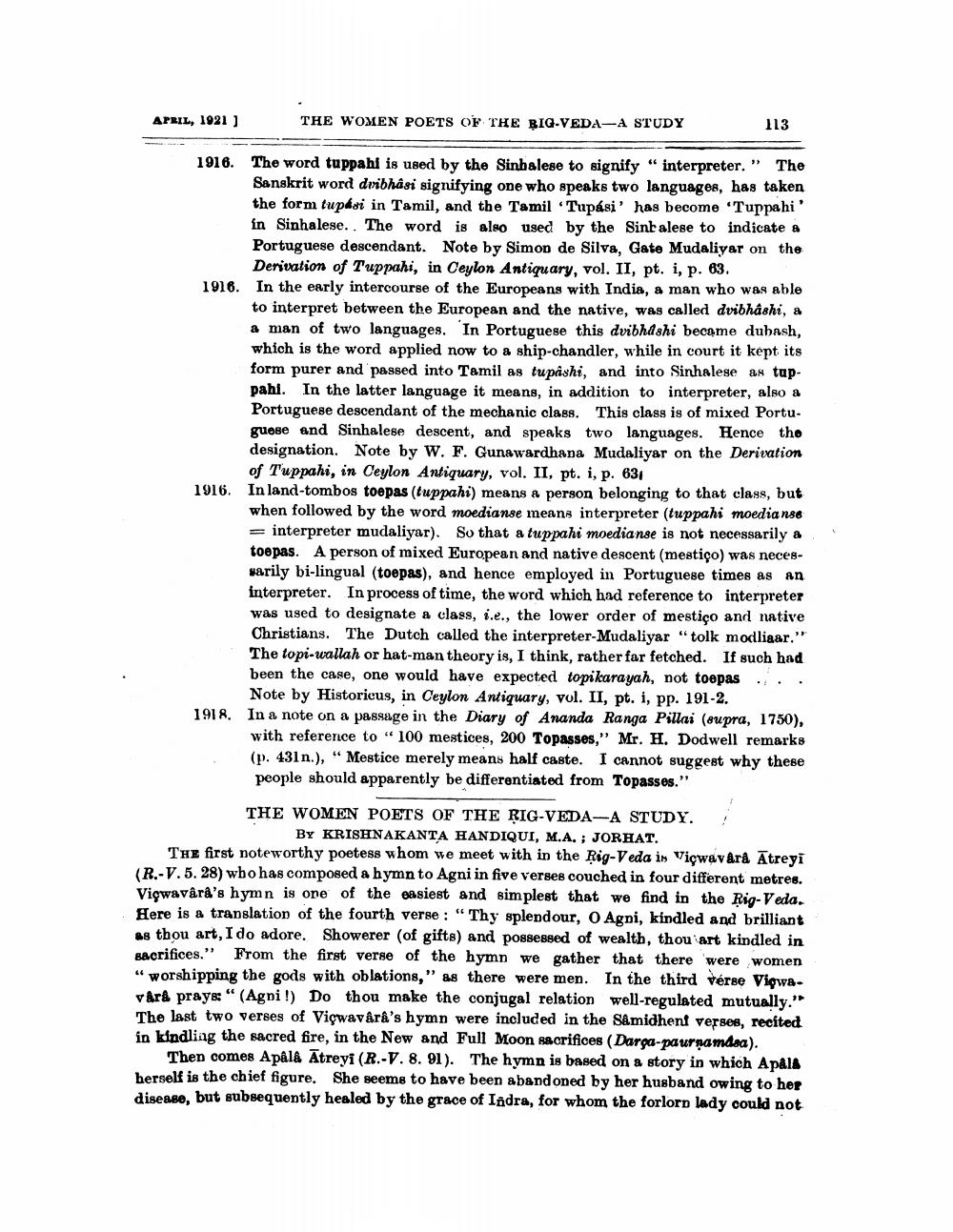________________
THE WOMEN POETS OF THE BIG-VEDA-A STUDY
33 The
1916. The word tuppahi is used by the Sinhalese to signify "interpreter. Sanskrit word duibhâsi signifying one who speaks two languages, has taken the form tupasi in Tamil, and the Tamil Tupási' has become "Tuppahi' in Sinhalese.. The word is also used by the Sinhalese to indicate a Portuguese descendant. Note by Simon de Silva, Gate Mudaliyar on the Derivation of Tuppahi, in Ceylon Antiquary, vol. II, pt. i, p. 63. 1916. In the early intercourse of the Europeans with India, a man who was able to interpret between the European and the native, was called dvibhashi, a a man of two languages. In Portuguese this dvibhashi became dubash, which is the word applied now to a ship-chandler, while in court it kept its form purer and passed into Tamil as tupashi, and into Sinhalese as tuppahi. In the latter language it means, in addition to interpreter, also a Portuguese descendant of the mechanic class. This class is of mixed Portuguese and Sinhalese descent, and speaks two languages. Hence the designation. Note by W. F. Gunawardhana Mudaliyar on the Derivation of Tuppahi, in Ceylon Antiquary, vol. II, pt. i, p. 631 1916. In land-tombos toepas (tuppahi) means a person belonging to that class, but when followed by the word moedianse means interpreter (tuppahi moedianse = interpreter mudaliyar). So that a tuppahi moedianse is not necessarily a toepas. A person of mixed European and native descent (mestiço) was necessarily bi-lingual (toepas), and hence employed in Portuguese times as an interpreter. In process of time, the word which had reference to interpreter was used to designate a class, i.e., the lower order of mestiço and native Christians. The Dutch called the interpreter-Mudaliyar "tolk modliaar." The topi-wallah or hat-man theory is, I think, rather far fetched. If such had been the case, one would have expected topikarayah, not toepas Note by Historicus, in Ceylon Antiquary, vol. II, pt. i, pp. 191-2.
1918. In a note on a passage in the Diary of Ananda Ranga Pillai (supra, 1750), with reference to "100 mestices, 200 Topasses," Mr. H. Dodwell remarks (p. 431n.), "Mestice merely means half caste. I cannot suggest why these people should apparently be differentiated from Topasses."
APRIL, 1921]
113
THE WOMEN POETS OF THE RIG-VEDA-A STUDY. BY KRISHNAKANTA HANDIQUI, M.A.; JORHAT.
THE first noteworthy poetess whom we meet with in the Rig-Veda in Vicwavârâ Atreyi (R.-V. 5. 28) who has composed a hymn to Agni in five verses couched in four different metres. Viçwavârâ's hymn is one of the easiest and simplest that we find in the Rig-Veda. Here is a translation of the fourth verse: "Thy splendour, O Agni, kindled and brilliant as thou art, I do adore. Showerer (of gifts) and possessed of wealth, thou art kindled in sacrifices." From the first verse of the hymn we gather that there were women "worshipping the gods with oblations," as there were men. In the third verse Vigwavåra prays: " (Agni!) Do thou make the conjugal relation well-regulated mutually." The last two verses of Viçwavârâ's hymn were included in the Sâmidhent verses, recited in kindling the sacred fire, in the New and Full Moon sacrifices (Darga-paurṇamása).
Then comes Apâlâ Atreyi (R.-V. 8. 91). The hymn is based on a story in which Apala herself is the chief figure. She seems to have been abandoned by her husband owing to her disease, but subsequently healed by the grace of Indra, for whom the forlorn lady could not




